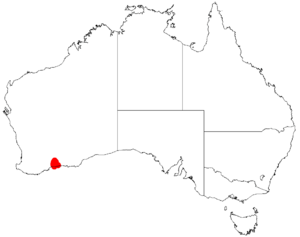Acacia ophiolithica facts for kids
Quick facts for kids Acacia ophiolithica |
|
|---|---|
| Scientific classification | |
| Genus: |
Acacia
|
| Species: |
ophiolithica
|
 |
|
| Occurrence data from AVH | |
Acacia ophiolithica is a special type of shrub from the Acacia family. It's a plant that only grows in a small area along the southwest coast of Australia. This means it's endemic to that region, found nowhere else in the world! It belongs to a group of acacias called Plurinerves.
What does Acacia ophiolithica look like?
This shrub is usually dense and rounded. It typically grows to be about 0.3 to 2 meters (1 to 7 feet) tall. Its branches are smooth, meaning they are glabrous. They also have small scars from where old leaf-like parts used to be.
Like most Acacia plants, it doesn't have true leaves. Instead, it has phyllodes. These are flattened leaf stems that look and act like leaves. The phyllodes of Acacia ophiolithica are thin, straight, and smooth. They stand upright and are quite close together. Each phyllode is about 1.5 to 4.5 centimeters long. They are very narrow, only about 0.7 to 1 millimeter wide. You can see four to eight faint lines, or nerves, on them.
This plant blooms from August to October. During this time, it produces bright yellow flowers.
How was Acacia ophiolithica named?
Scientists who study plants are called botanists. Two botanists, Richard Sumner Cowan and Bruce Maslin, first officially described this plant. They did this in 1995. Their work was part of a larger study about Acacia species. It was published in a science journal called Nuytsia.
Later, in 2003, another botanist named Leslie Pedley changed its name to Racosperma ophiolithicum. However, in 2014, it was moved back to the Acacia group.
Acacia ophiolithica is part of the Acacia fragilis group. It is very similar to Acacia uncinella. People sometimes confuse these two plants because they look so much alike.
Where does Acacia ophiolithica grow?
This plant is native to a specific part of Western Australia. It grows along the south coast, in the Goldfields-Esperance region. You can often find it along river banks and in rocky areas. It prefers to grow in loamy or clay-loam soils.
Acacia ophiolithica has a limited natural range. However, it is quite common in the areas where it is found. It grows around the Jerdacuttup River, which is east of the town of Ravensthorpe. Here, it often grows among Eucalyptus trees in what are called mallee communities. It can also form thick, dense groups of its own.

